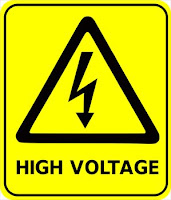voltage is potential difference is the amount of a charge with other charges and units called volts ( v ) , the voltage can be simply described by a strong flow of water. power voltage is rushing water, the greater the force pushing the water, the greater the energy to move something, so does the voltage, the greater the voltage, the greater the power generated to supply the equipment.
voltage in physics can be described by the potential energy contained in a substance to other substances. this was due to differences in the amount of negative charge and positive charge amount contained in a substance. suppose a substance (a substance we call A) has a number of negative charge and positive charge 10 pieces 30 pieces the substances they lack the negative charge as much as 20 pieces, therefore they have the potential energy of 20 pieces and that means the voltage of an object against the object the other is -20 pieces, but depending on the substance to be paired, if the substance partner (we call substance B) has an energy shortage -10 or negative charge 10 pieces of the voltage or potential difference of objects a and B is (-20) plus (-10) then the result (-10) but within the science of electricity is not as easy as a matter of the above there are several factors for the in put. maybe next time we will discuss.
voltage in an electrical distribution network can be categorized into low voltage - high voltage - high voltage, masing2 have a certain amount of restriction in any groups. in some countries the standard voltages to the end customer and the 110 volt range for 1-phase 220 volts and 380-400 volts for 3 fasa.dan these included low voltage. while to raise the voltage and lower voltage used a device called a voltage transformer, step-up transformer to raise the voltage, whereas for reduce the voltage devices called step-up transformer.
voltage transformer can only work on alternating electrical current.
tool used to measure the voltage such voltmeter, oscilloscope, and others. measurement circuit coupled parallel with the voltage to be measured
The following are a few tables voltage calculation:
· 1 Mega volt (Mv) = 1,000,000 volts
· 1 Kilo volt (Kv) = 1.000 volts
· 1 Mili volts (mV) = 0.001 volts
- P = V x I
- V = ( I x I ) x R
* P : Power (W)
* V : Voltage (V)
* I : current (A)
* R : Resinstance ( Ohm )

No comments:
Post a Comment